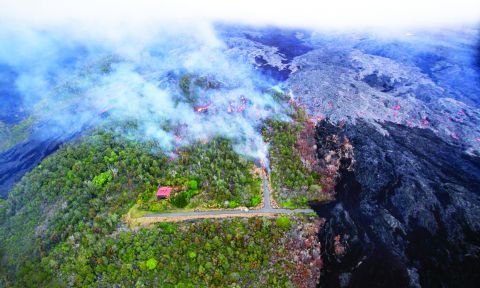
Jack Thompson, looking at the unstoppable river of molten rock bearing down at his home of nearly 30 years, delivered the epitaph on Friday: "This is probably the grand finale."
He was reached Saturday evening from his other home in Ainaloa.
"I got as much stuff out there as was practical and everything else, had to leave it. It (the lava) was pretty much coming in the back as we were going out the front," Thompson said. "We left about 6 o'clock it was still light."
He took whatever he could stuff into two empty choppers from Paradise Helicopters. An hour later, some of Thompson's friends in Kalapana Gardens (near the county's lava viewing area several miles away) saw a bright light go up from what used to be a bed and breakfast.
It was the final act in the destruction of a vast but sparsely populated neighborhood dating back to the earliest phases of the Pu'u 'O'o-Kupaianaha eruption in 1983. Over the years, flows from Kilauea had burned his neighbors' homes and cut off the roads leading to Royal Gardens. In 2008, his last neighbor's home succumbed. Thompson began walking the 3 or 4 miles to Highway 130 over rough lava rock, hauling a backpack heavy with brown rice and beans. Those days appear to be over.
A professional photographer and friend, Leigh Hilbert, happened to be staying at the house and was able to help Thompson evacuate.
Hilbert had been documenting the progress of the flow on his blog, hawaiianlavadaily.blogspot.com. Arriving by foot on Thursday, he noticed one threatening branch and told Thompson, who continued to hope it could miss his house, as others have in the past.
"We were up there just kind of watching it and seeing what it was going to do, and it kind of went down the east side, down Hoku Street," Thompson said. "I'm on a point that's steep all around me, but I really thought I had a chance to ride this one.
Thursday evening, Hilbert hiked up to take more photos. Through the smoke and the fumes, he saw "a bright, high mound of lava flow. That's the one that concerned me," Hilbert said.
Friday afternoon, Hilbert and Thompson took a trek uphill and found that the flow was just 220 feet away from the house.
"I kind of had to push him," he said. "He was kind of like, 'Well, maybe tonight or tomorrow.'"
A couple hours later, Hilbert measured the flow again. By his reckoning, it had advanced 45 feet through the forest in the last hour and a half or so. He brought Thompson up again.
"We only walked 145 feet. And there it was."
"There was an outbreak right behind me that was in a little trough, a little valley, that was directing it right toward the back of the house. Once it got in there I knew it was pretty much it," Thompson said.
"And then his whole demeanor changed," Hilbert said of his friend. As the realization sunk in, Thompson said, "This is probably the grand finale."
It was about 3 p.m. The two began picking up important things. Thompson used his cell phone to call Paradise Helicopters to arrange a ride; he called back later and requested a second chopper. A helicopter in the middle of a tour landed at the property to give the two men a VHF radio to communicate directly with the pilots.
Hilbert and Thompson were given about 90 minutes before the two choppers would land at about 5 p.m.
"Man, we started this just in time," Hilbert recalled Thompson telling him.
They brought all they needed to the road and Thompson wanted to go up and see if the flow had stalled. It was now just 100 feet from where they were.
"We knew we were just getting out of there in time," Hilbert said. After the two loaded up the helicopters with the help of the pilots, Thompson took one last look at his home. He told Hilbert he locked the door.
They didn't stay to watch the house go; it was getting too dark and rainy, and the choppers had no place to land.
Oddly enough, losing his house isn't what burns Thompson. On Feb. 23, the state published a draft environmental assessment for a helicopter landing pad at his property. Paradise Helicopters was seeking a special permit to build a 15-by-15-foot platform, but now there's no place for visitors to go. Asked about this, he unloaded years of frustration at the county Planning Department, which had prevented him from keeping a bed and breakfast or hosting visitors on helicopter tours.
"Unfortunately, the fools down at the Planning Department fooled around for a couple of years that I could have been making some money," he said. "We could have been having a good time. The tourists could have been having a good time. But while they fooled around down there and playing their little games: 'Let's have a little environmental impact study and let's see if there's any endangered plants out there or any endangered fruit flies' or something. I mean, it's ... ridiculous."
"That's the worst part of it. The rest of it, I can handle. It's nature. It's not some damn fool trying to harass you so that they can have a job."
In the end, luck ran out on Thompson's house the same way it did for his neighbors. A pause in the lava supply, followed by a surge, caused the flow to break out of its tube in just the right place and flow down the pali. It is in some ways a wonder that a building could exist despite more than 29 years of near-constant eruptive activity.
"I've been preparing for this for years. You're hoping for the best, but in time expect the inevitable," Thompson said. "It could have gone somewhere else just as easily, but this time I was in the way."



Reader Comments
to our Newsletter